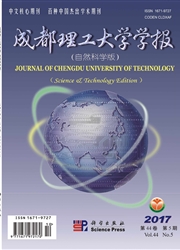

 中文摘要:
中文摘要:
以野外露头剖面和钻测井资料为基础,结合显微薄片鉴定,对黔南-桂中地区的二叠系进行了层序地层、沉积体系和古地理演化研究。将二叠系划分为2个超层序(或称为二级层序)和12个三级层序;识别出了海岸沉积体系、碳酸盐台地沉积体系和台盆沉积体系,黔南地区以台地相为主,桂中地区则以“台-盆”相间为特征。通过层序地层格架内的古地理演化研究表明:早二叠世,受全球海平面变化和构造抬升作用的影响,黔南地区为暴露剥蚀区,桂中地区为“盆-隆”相问的沉积格局;中二叠世,受海侵作用的影响,黔南地区以台地环境为主,桂中地区演变为“台-盆”相问的沉积格局;晚二叠世早期的东吴运动造成研究区大面积隆升剥蚀;晚二叠世中晚期,海侵作用使黔南地区再次成为碳酸盐台地环境,并且在桂中地区则再次形成台-盆相间的沉积格局。上述盆地结构演化控制了礁滩相带的分布。
 英文摘要:
英文摘要:
Based on the data of outcrop measurements and drilling wells and combined with the determination of thin sections, the paper analyzes the microfacies and divides Permian into 2 super sequences and 12 third-order sequences. The coast, carbonate plateau and platformal basin sedimentary systems are recognized after studying the sequence stratigraphy, sedimentary system and evolution of palaeogeography in South Guizhou and Middle Guangxi. Carbonate plateau facies is dominant in South Guizhou and platform-basin facies in Middle Guangxi. The evolution of palaeogeography in the stratigraphic framework shows that South Guizhou was a denuded area because of the affections of sealevel changing and structure uplift and Middle Guangxi wasa alternate pattern of plateau and uplift in Early Permian; Carbonate plateau dominated in South Guizhou and the alternation of plateau and uplift did in Middle Guangxi because of the rising of sealevel in Middle Permian; The study area uplifted and exposed because of the Dongwu tectonic movement in the early phase of Late Permian; Carbonate plateau dominated in South Guizhou again and the alternation of plateau and uplift occurred again in Middle Guangxi because of transgression in the middle-late phase of Late Permian. The above basin structure evolution controls the reef facies distribution.
 同期刊论文项目
同期刊论文项目
 同项目期刊论文
同项目期刊论文
 期刊信息
期刊信息
